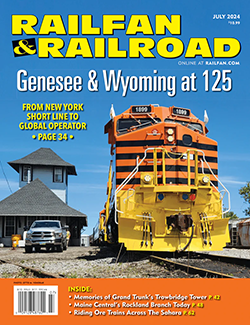 American builders have long supplied equipment to railways overseas. The most famous example is likely Baldwin, that in 1897 supplied 20 2-8-2 steam locomotives to the Japanese Ministry of Railways. Ever since, this wheel arrangement has been named “Mikado,” an outdated title for the Japanese emperor. Less well-known are American diesel exports. Typically, there are two types — engines purpose-designed for export and domestic designs offered, with varying modifications, to global markets.
American builders have long supplied equipment to railways overseas. The most famous example is likely Baldwin, that in 1897 supplied 20 2-8-2 steam locomotives to the Japanese Ministry of Railways. Ever since, this wheel arrangement has been named “Mikado,” an outdated title for the Japanese emperor. Less well-known are American diesel exports. Typically, there are two types — engines purpose-designed for export and domestic designs offered, with varying modifications, to global markets.
General Motors’ Electro-Motive Division (EMD) was particularly prolific at the former type. Consider the G8, produced beginning in 1954. Mechanically similar to the domestic SW8 switcher, the G8 looked more like a shrunk-down GP7, with its unique, smoothed-over road-switcher body and reduced profile. The G8 sold to customers in 10 countries, with 385 built; many remain in service today. Alongside this, EMD also produced the GA8, G12, G16, G20, and numerous other variants of these designs.
Then there’s General Electric, which produced export diesel-electric locomotives beginning in the mid 1950s, the “Universal” series of designs. Thousands were built, spread across dozens of model types, sold to railways in South America, Africa, and east Asia. The development of the “Universal” exports led directly to the production of the U25B released to the domestic market in 1959.
The export locomotives I find more fascinating, however, are those that were originally designed for the North American market but sold, with varying degrees of modification, for export. Some were almost “off the shelf” designs, such as the dozen RSC-2 road-switchers American Locomotive Company sold to Portugal’s Caminhos de Ferro Portugueses in 1948. With the exception of buffers on the pilots, these look like they might have been straight off an American road, and served out more than 50 years hauling both passenger and freight trains in the mountains near Porto. Alco also sold streamlined PA-2s in Brazil and S-1 switchers in Wales. There are GE Evolution-series engines in Australia, EMD F-units in Saudi Arabia, and, as you’ll read starting on page 62, EMD SD70ACS units toiling in Mauritania.
At the other end of the spectrum is the DDM-45, built by EMD for Brazil’s Estrada de Ferro Vitória a Minas (EFVM). Locomotive enthusiasts who know their designation numbers will not be surprised to learn that these were closely related to North America’s 20-cylinder, 3,600-hp SD45. Visually, they look almost identical, at least from the frame up. The EFVM is, however, a meter gauge system, so these SD45 cousins ride on narrow, but long, four-axle trucks. Visually, these stretched versions of the EMD Flexicoil resemble the outside frame of a narrow-gauge steam locomotive or, perhaps, the centipede trucks of a main line steam tender. A more recent variation on this theme is the SD70ACe-BB, an EMD locomotive that looks much like a domestic SD70-series but that rides on four pairs of two-axle trucks.
Beyond export models like the G8 and the modified designs such as the DDM-45, there are the numerous “license-built” locomotives, based on American designs but constructed by factories ranging from Sweden to Australia, from England to India. Once you get past the trivia of model designations, production numbers, and modifications, export models demonstrate how thin and arbitrary the line is between “domestic” and “foreign” railways. Yes, North American railroading has a distinct character, but “exports” reinforce how railways also bind us together.
Alexander Benjamin Craghead is a transportation historian, photographer, artist, and author.



